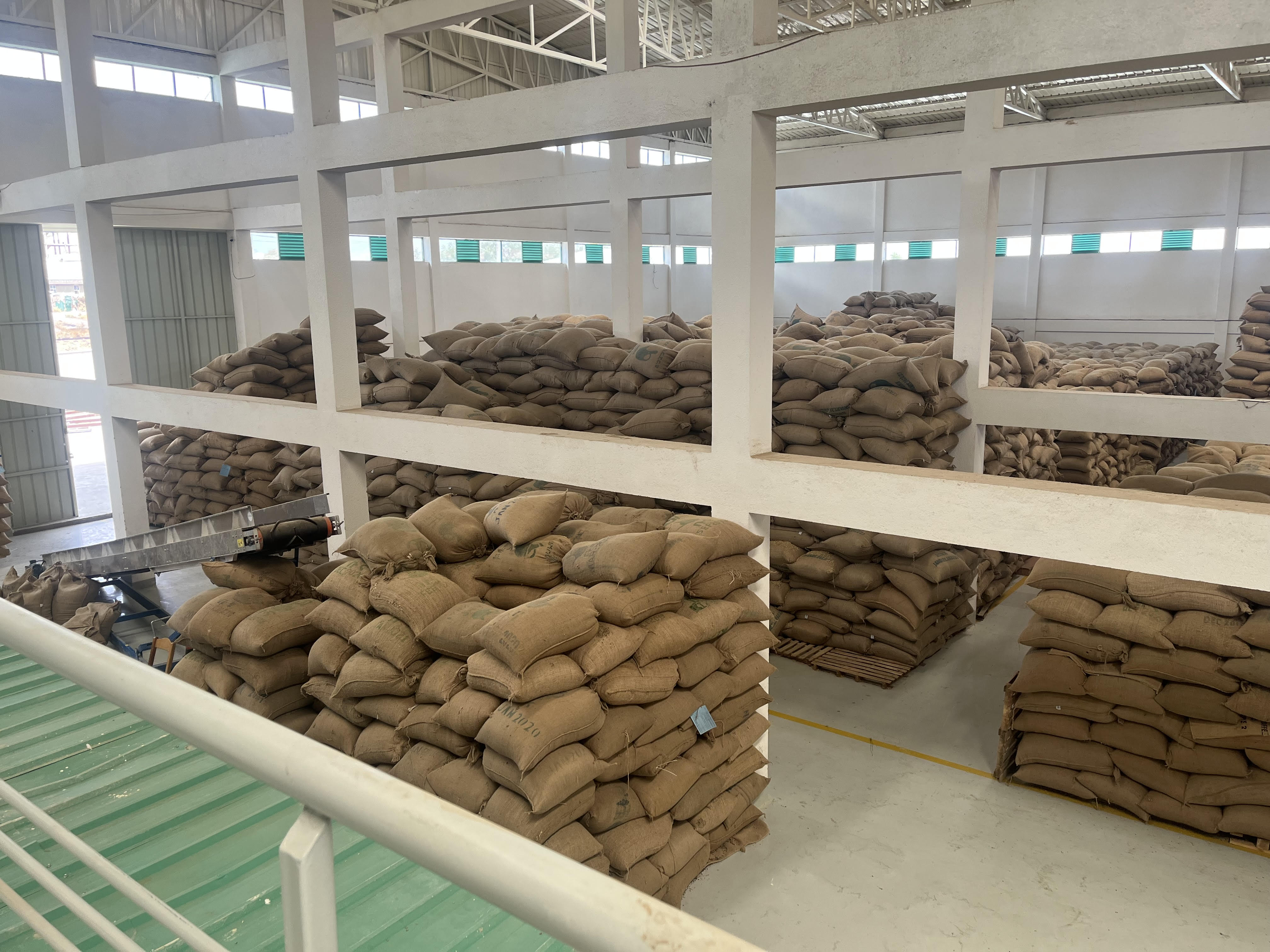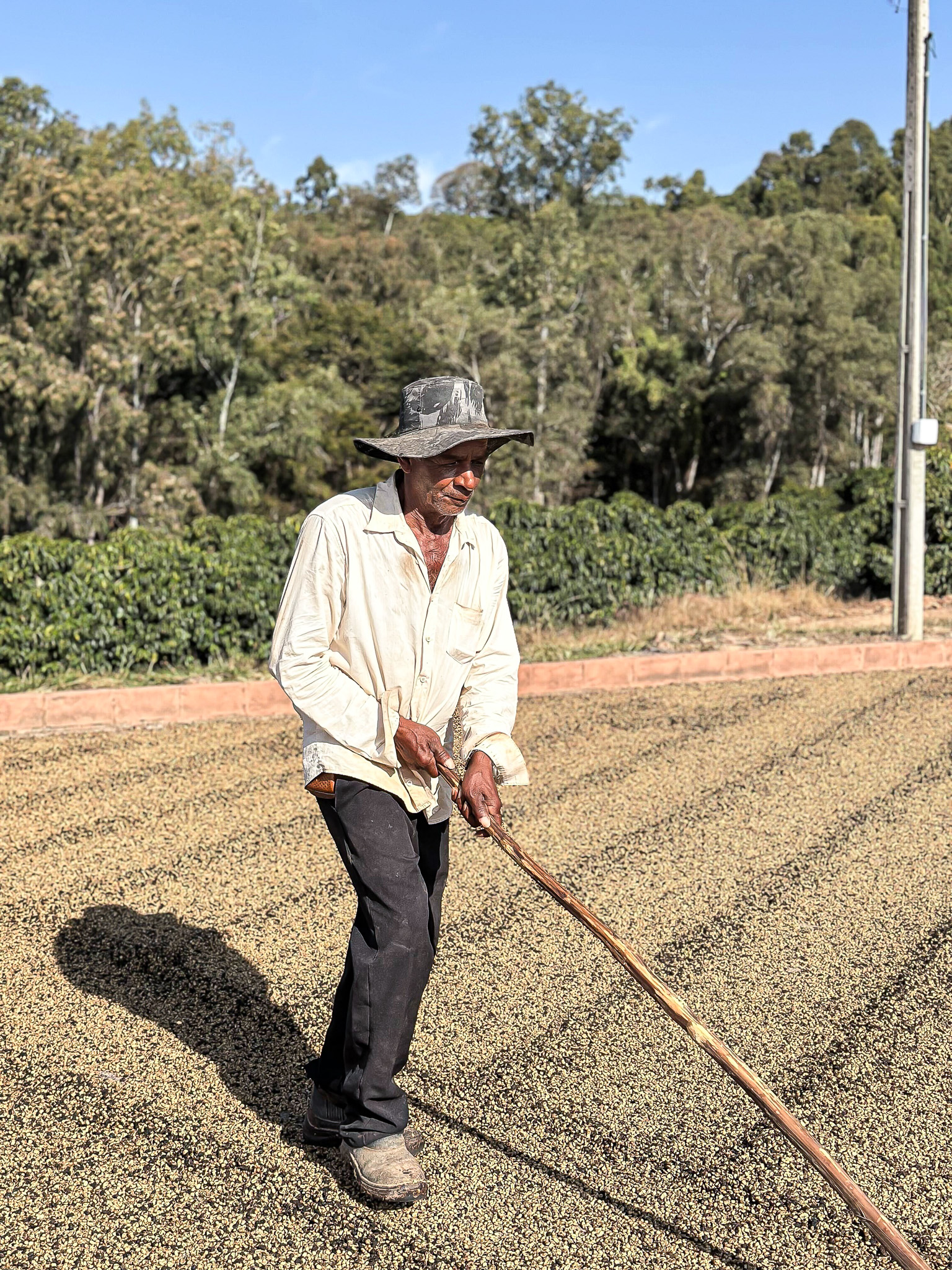Kenya

Diverse varieties and exceptional post-harvest techniques within a transparent, quality-focused supply chain.
Since we started sourcing from Kenya in 2012, we have focused on offering a unique range of flavour profiles, including well-known flavours like blackberry and black currant, and lesser-known flavours like hoppy florals and citrus fruits. With transparent access to the supply chain via our trusted partners, we prioritise our relationships with Farmers Cooperative Societies, who manage the factories we source from.
Harvesting season
October - January
Arrival times
March - May
Quantities
Varies from 5 – 50 bag lots. Average is 20 bag lots.
Packaging
30 kg vacuum boxes & 60 kg grain pro bags
Cultivars
Mainly SL 28, SL 34, K7
Processes
Fully washed and sun-dried on African beds
Flavour profiles
Blackberry, black currant, plums, stone fruit, florals, & citrus fruits
Usage
Widely used for filters, more seldom as espresso
Shelf life
Normally holds up well for a year. We can never guarantee more than 6 months after arrival for any coffees.
We prioritise building relationships with Farmer Cooperative Societies (FCS) that own and operate coffee processing factories (washing stations). These FCS may oversee multiple factories. While we prioritise purchasing from the same factories annually, we are also open to establishing relationships with producers of any scale in any coffee-growing region. Our coffees primarily come from smallholder farmers who deliver their harvest to washing stations managed by various FCS in Central Kenya.
These factories procure cherries from smallholders and small-scale farm owners (typically with a few hundred trees). These cherries are combined into a daily lot, usually comprising cherries from hundreds of different smallholders. Even the most renowned factories exhibit a range in quality. The FCS oversees the processing and shares the profits with its members.
In recent years, we've shifted our focus from Nyeri county to Kirinyaga county due to the discovery of higher-quality coffees there. Additionally, we source from other counties such as Embu, Muranga, and Kiambu. Given the relatively high price points for coffees in Kenya, we meticulously cup through the outturns to select the best-performing coffees each year. We maintain relationships with reliable suppliers to ensure that premiums are returned to the producers, many of whom take pride in delivering favourable returns to the farmers.
How coffee is bought
A producer typically has agreements with the factory they deliver cherries to. When the consignment is ready, the parchment is delivered to the factory, typically around 200 bags, equivalent to around 130 bags of exportable greens.
Previously, exporters could buy coffee through auctions or negotiate prices with cooperatives via marketing agents. However, this system changed in 2023, with new regulations in place. Marketing agents have been replaced by brokers who require specific licences to operate.
Exporters now must wait for coffee to enter auctions before acquiring samples and making purchases. This means they can no longer buy directly from cooperatives or access early samples as before.
Despite these changes, exporters can still secure quality coffees through the auction process, albeit with adjustments. The milling process has also changed, with the majority of mills now government-owned, aimed at preventing concentration under multinational entities.

A step-by-step overview

Kenyan coffee production is divided into smallholder cooperative societies, small estates, and large estates. More than 50% of production comes from cooperative societies. The individual factories are responsible for production, management, and overhead costs, while the cooperative society monitors financing and sells the coffee.
Factories typically have about 1000 farmers delivering cherries and give a small advance payment at delivery. The better and well-managed factories are able to give more than 85% of the sales price back to the farmers. Small estates, while having the potential to produce amazing coffees, often blend their coffees randomly due to their smaller production capacity.
Large estates, mainly located on the outskirts of Nairobi, use dense planting, high maintenance plant treatment, and irrigation to produce up to 1.5 kg of greens per tree. While good coffees can be found among the estates, in general they lack the flavour intensity and complexity found in other Kenyan coffees.
Cherry delivery takes place at the factories or at collection centres. When the farmers arrive to the point of delivery, they normally have to empty their bags on the floor (on a cover) to sort out unripe, overripe and CBD infected cherries. A supervisor inspects the cherries before they are weighed and the farmers get a small up front payment for the delivery. The delivery from every farmer is registered and they get a receipt for the amount.
This will be the base for their right to payment after the coffee is sold. Some farmers are organised in groups or associations to be able to cooperate on investments for soil inputs and necessary equipment for farming.
E (Elephant beans) screen 19 and up. AA = 17/18, AB = 16/17, PB = Peaberries. The rest are lower grades such as C = below 14, TT and T are the low-density beans over and under screen 14. In the mill, everything is kept separate for the auction, and it’s a great opportunity to cup through the different grades from the same outturns and consignments. At this stage, we extensively cup at the mill, to pick out our coffees before they enter the auction catalogue.
After the coffees are weighed, they go into the main cherry hopper above the pulper. Some wet mills have a separate hopper for the low grades, such as under and over ripes. When they start the pulper, the cherries gravitate into the machine. They normally use disc pulpers, such as old three-disc Agaarde or similar brands. As long as the discs are changed from time to time, they can work perfectly well.
It’s also important to adjust the pulper to remove the pulp (fruit) properly without damaging the parchment. The parchment flows from the discs with water, allowing the parchment to be separated by density. The densest beans will sink and are pumped straight through a channel to the fermentation tank as P1 (parchment 1), the semi dense will go to a separate fermentation tank as P2. The floaters, P3, are considered as low grades and will normally go straight to the drying tables. Processing methods are more or less similar for most cooperatives or large estates.
After pulping, the coffees are dry fermented (water is drained off) in painted concrete tanks. They are normally fermented for 18-24 hours. Many factories do intermediate washing every 6-8 hours, meaning they add water, stir up the parchment and drain it again. When fermentation is completed and the mucilage is dissolved, the parchment gets washed in washing channels and graded again by density. The lighter beans will float off and the remaining, dense parchment will normally be soaked in clean water for up to 24 hours.
After soaking, the coffees are skin dried on hessian mesh mats for up to one day. This is to quickly eliminate the moisture on the surface of the parchment. After a day, the coffees are typically moved to traditional drying tables. The coffee is then dried on a surface of jute clothing or a shade net on top of the wire mesh. The parchment is constantly moved as they sort out defected parchment and beans.
The coffee has to be covered with plastic during the hottest periods of the day, as well as during the night. The drying time varies between 12 and 20 days, depending on the weather and rainfall. The moisture target is 11-12%. In Kenya, there is also a tradition of intermediate conditioning, depending on the producer’s approach and drying table capacity. Some producers take the parchment into conditioning bins, during what they call “the black stage”, when the coffees are stabilised at around 16%. They can be conditioned for some weeks before they are placed on the drying tables again, to finish off the drying.
Quality
Farmers in Kenya can select the factory where they deliver their cherries, with several options often available. Well-managed factories compete for cherries by rewarding nearby farmers to maintain their loyalty, prioritising quality in Kenya's auction system to command higher prices for superior coffees.
We seek characteristic flavour profiles in our coffees, including jammy blackcurrant notes, and we procure natural lots with exceptional cup scores. There's a growing diversity of flavours emerging, with development in lesser-known regions focusing on higher quality. Common flavours include blackberry, black currant, grapes, and intense florals, as well as red berries, plums, stone fruit, hoppy florals, and citrus fruits. Additionally, there's a presence of more fermented and process-driven profiles from washed coffees undergoing extended fermentation.
Transparency
The traditional auction system in Kenya is very transparent, with everything clearly separated into small lots and different grades. Farmers know exactly what portion of the sales price goes back to the cooperative society after processing costs. Some cooperative societies and factories are able to pay back up to 90% of the sales price after deducting marketing and preparation costs.
We offer detailed information on all products as well as price transparency throughout the supply chain. You will usually have access to what we paid to the farmers and the FOB price.
Impact
We collaborate with partners engaged in specialty coffee and initiatives aimed at farm sustainability, fair pricing, and quality bonuses for farmers. Our main emphasis lies in fostering long-term relationships with Farmer Cooperative Societies (FCS), ensuring consistent sourcing from the same producers annually. However, we also remain open to acquiring exceptional coffees from new producers or washing stations if they stand out during cupping evaluations.

About the origin
Kenya, located between longitudes 34-42 and latitudes 5, covers an area of 580,000 square kilometres and is home to approximately 43 million inhabitants. The country's main coffee growing areas are around Mt. Kenya in Central Kenya and west towards Mt. Elgon at the border of Uganda.
Kenya's yearly production of green coffee ranges from 45,000 to 65,000 tons and consists mainly of fully washed coffees. Kenya is known as the world's top quality producer, with over 700,000 smallholder coffee farmers, representing about 55% of the production. The rest are mainly estates, with 3000 small estates of less than 20 hectares, 300 larger ones, and about 1,100 cooperative wet mills. Coffee exports make up approximately 10% of Kenya's income.
The coffee industry in Kenya began with British colonists in 1897 and went through significant changes in the 1930s when the Kenya Planters Cooperative Union became a dominant voice of the Kenyan coffee planters. In 1932, the Coffee Board of Kenya was established, and in 1934, they established the coffee auction. In 1978, the smallholder sector surpassed the large estates in terms of production, accounting for more than 50% of total production.
However, the coffee plant faces challenges, such as the fungus that causes Coffee Berry Disease and leaf rust, which can be treated with expensive copper-based fungicides.
Interested in this origin? Talk to your sales rep.





What’s new?
The latest updates delivered to your inbox.
Subscribe to our newsletter for the freshest news on origins, harvests, new producers, our coffee list, and market insight.

.jpg)














.jpg)



.jpg)
.jpg)

